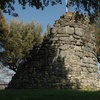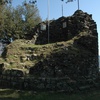Castle of Palleroso
Palleroso is a small village which was fortified in mediaeval times. Parts of the antique layout of the defensive walls which skirt the access ramp to the front door of the castle have been preserved. In the highest part of the village, the ruins of the ancient circular tower can be found, built in large blocks of sandstone, which in the past was used for visual warnings, connected to the other towers of the valley.
The church of S. Martino is mentioned for the first time in a Papal Bull from 1168, but has undergone numerous renovations that have completely changed its appearance. Inside there is an oil painting by the Venetian painter Giò Battista Lorenzetti representing the Virgin and Child with Saints.
Historical notes
Despite the importance that this site must have enjoyed in the past, news about it is scarce. The first mention of a "Palarosus site" dates from the year 996, when the Prelate of Lucca, Gherardo, entrusted some properties located in the village to Sisesmondo, a member of the coterie that was among the greatest representatives of the Rolandinghi di Loppia.
The parish church of "Sancti Martini de Pallaroso" was nominated in 1168 in the Bull of Alessandro III, which sanctioned the privileges of some churches of the Garfagnana, mentioning the church of Palleroso among the dependencies of Pieve Fosciana.
The village often came into conflict with the government of Lucca, which had already conquered the castle in 1170 and subsequently sent its army to suppress uprisings in 1372 and 1383.
In the Guinigiana era, the castle of Palleroso was among those that were to be kept well supplied with provisions and fortified carefully in order to defend the borders of the state.
When the Lord of Lucca fell, the village initially remained faithful to the ancient rulers, but in 1451 this centre also decided to pass under the control of the Este.
In 1603, when the State of Lucca and the Este competed for dominion over the valley, Palleroso suffered the devastating effects of a brigade of soldiers on horseback from Lucca. At that juncture, notwithstanding the fortification being in good condition and well equipped, it is said that at the first shot of the artillery, the army and the people of Palleroso surrendered ignominiously, leaving the town to the devastation and plunder of the enemy. So it was that "Palleroso was looted, the church was plundered, the Altars were stripped, the bells were removed"; the village was also burned and the fortifications damaged. The town was rebuilt by the hard work of the inhabitants but this military action ended the history of the fort, which gradually fell into disuse.











